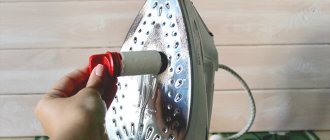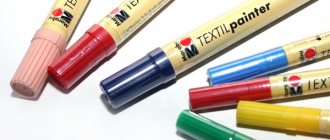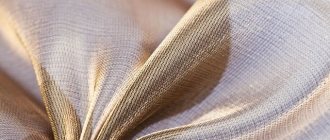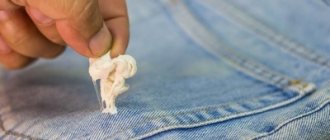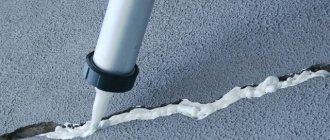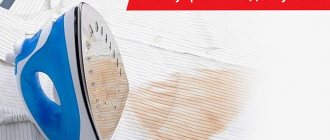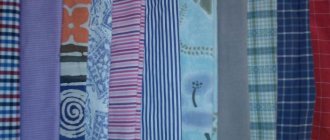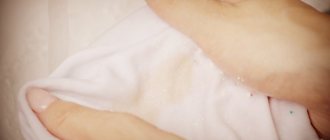Being a good housewife means being able to cope with any complex household chores. In this article I will share one useful trick on how to clean the iron from burnt fabric. These tips will help you not only avoid this problem, but also easily eliminate its consequences.
To prevent the fabric from burning, set the temperature indicated on the label.
If the iron is burnt, it means that mistakes were made in its operation. Most likely, you did not set the correct temperature for the material you are using. You can deal with carbon deposits, the main thing is to use products that are suitable for the fabric. If the iron suddenly catches fire, do not extinguish it with water. Read the article “What cannot be extinguished with water - a complete list of substances.”
Why does fabric stick to the iron?
Failure to comply with them leads to premature wear and damage to things. One of the most common problems is fabric sticking to the iron platform. The main difficulty is that the iron is no longer suitable for use. It is quite difficult to remove pieces of fabric stuck to the iron on your own. Knowing the causes will help prevent the problem.
Often, various contaminants appear on the base of an electrical appliance during operation: carbon deposits or scale.
Causes:
- overexposing the iron to things - this often happens when attention is distracted;
- sensor malfunction, incorrect heating display - ironing delicate fabrics at maximum temperature leads to burning;
- the presence of metal, cellophane, plastic, leather fabrics on things;
- violation of the rules for cleaning the surface of the iron - for these purposes it is not recommended to use knives, metal brushes, or powders for treating kitchen surfaces;
- excessive temperature conditions - microfibers remain on the sole of the iron, the accumulation of which leads to the formation of carbon deposits;
- the use of low-quality water - limescale in the water leads to the formation of roughness on the surface of the iron, a decrease in the quality of sliding, and the formation of carbon deposits;
- damage to the platform - scratches, microcracks reduce the quality of ironing;
- failure to follow the rules for ironing delicate fabrics.
Most often, burning occurs due to inattention to the recommended temperature conditions and leads to difficulty in ironing.
In most cases, fabric sticks to the iron when ironing at the wrong temperature.
When ironing delicate fabrics, it is recommended to use damp gauze.
Method 7. Hydroperite
If you are a blonde who uses hydroperite the old fashioned way, then this method is for you! If it lightens the hair, then it will quickly deal with the carbon deposits on the iron.
But, remember that this is a rather aggressive product and an inexpensive iron may not withstand the experiment.
So, how to clean an iron with hydroperite tablets:
1. Dilute the tablets until mushy
2. Apply this mixture to the sole
3. Warm up the device and then cool it down
4. Wipe off any remaining tablets with a cloth
How to remove stuck fabric from an iron
You should first find out the type of surface of the iron platform, which will help you choose the right cleaning method. The procedure is most often carried out with the iron turned on; you should worry in advance about the place where the device could be plugged into an outlet. When using special store-bought products, it is recommended to follow the instructions exactly. You will need a soft cloth for cleaning. During the procedure, you should keep your distance from the steam holes. Following these rules will help prevent possible problems.
It is advisable to clean the sole as soon as contamination occurs.
Cleaning with vinegar
Vinegar will help get rid of burnt fabric.
Cleaning methods:
- Wipe the platform with a cloth soaked in vinegar—this method is recommended for removing fresh, mild plaque.
- Place a cloth soaked in a large amount of vinegar under the iron overnight - this method is suitable for removing old stains. Under the influence of an acidic liquid, the stain will soften and peel off. At the final stage, it is recommended to wipe the surface with a dry cloth.
Be careful: vinegar should not come into contact with the iron body during the procedure.
Laundry soap
It is recommended to use laundry soap immediately after stains form. It is recommended to apply laundry soap to the hot sole. A cold iron should be cleaned of traces of dirt.
The hot soleplate of the iron should be generously lubricated with laundry soap in places where burns accumulate.
Salt
Salt is considered the most effective means for cleaning an iron. Its main advantage is its accessibility; it is present in every home without exception.
Recipes:
- Sprinkle ½ cup of salt in an even layer, iron the additive with an iron heated to maximum temperature until the stains completely disappear.
- Wrap a handful of salt in a natural cloth and carefully apply it to a heated iron until the stains disappear.
Cleaning your iron with salt is the easiest way to get rid of carbon deposits on the soleplate.
Important! It is not recommended to use salt when cleaning Teflon coating; any abrasive compounds are also prohibited.
Candle paraffin
When cleaning an iron, paraffin shows its effectiveness. An ordinary candle is suitable for these purposes. The method allows you to get rid of small contaminants and helps in removing plaque of various origins.
Application steps:
- wrap the candle in cotton fabric;
- run a candle over the heated sole, the melted paraffin will flow down along with the dirt.
Paraffin can get into the grooves and stain your items during subsequent ironing.
During the procedure, a small angle must be maintained. This will ensure that the cleaning solution drips onto the previously prepared rag. At the final stage, it is recommended to wipe the surface with a damp cloth.
If there is a “steam” function, the holes on the soleplate of the iron are additionally cleaned. To do this, press the steam button several times to fill the water tank.
This will help prevent greasy wax stains from forming on the fabric.
Toothpaste
Toothpaste is suitable for cleaning stainless steel surfaces. To do this, you need to apply the product to a preheated sole. Using an old toothbrush will help increase the effect; it will allow you to scrub away the carbon deposits. At the final stage, the surface should be wiped with a damp cloth and wiped dry.
Using a toothbrush, you need to treat areas of contamination on the sole of the device.
Important! When choosing a paste, preference should be given to regular white paste without abrasive particles or other inclusions in the composition.
Baking soda
When cleaning metal surfaces, it is recommended to use baking soda. The substance has abrasive properties and caution should be exercised when using it.
Cleaning steps:
- mix soda with water;
- apply the composition to a cold surface for 20 minutes (for old stains);
- Gently wipe away marks with a soft cloth;
- Wash off the residue with a damp sponge.
Soda is a simple and cheap means at hand that effectively removes carbon deposits on the base of the device.
Important! It is recommended to use soda in cases where other means have proven ineffective.
Method 2. Fine salt
To do this, you need to sprinkle a (quite significant) handful of salt onto a piece of A4 paper or some scrap fabric. Choose “Extra” salt, not coarsely ground.
Heat up the iron and move the soleplate across the salt. In theory, it should absorb the remaining carbon deposits. Just remember that salt is an abrasive and do not use this method on models that cannot be cleaned this way.
Step-by-step instructions for cleaning an iron with salt:
1. Heat
2. Sprinkle salt on paper
3. Run a hot iron over the salt.
4. Wipe the cooled sole with a clean cloth
If a badly burnt sole cannot be cleaned off immediately, then give up this idea and do not try to rub as hard as possible with salt.
Iron cleaning products
Stores sell special pencils and liquids, the use of which ensures rapid removal of dirt, corrosion, and scale.
Steps to clean an iron with a pencil:
- set the switch to medium temperature, heat the iron;
- wipe the sole with a pencil - the product will melt upon contact with a hot surface and flow off with dirt;
- remove traces of fabric using a rag.
A pencil is a special device for cleaning an iron.
Important! Caution is advised when using pencils. The active substance is acid. Melting is accompanied by a pungent odor. Avoid getting the product on your skin, as contact with it can cause painful burns.
Liquid products
When purchasing, it is recommended to pay attention to the type of surface for which the product is used. The compositions help get rid of different types of stains and form a special protective film on the surface of the platform.
You can clean the iron from scale using special chemicals.
Sponges
Sponges help get rid of old stains and scale. Their use is not recommended when processing polished surfaces and non-stick coatings.
Clean the surface with a sponge, being careful not to allow water to seep into the appliance.
Cleaning mats
Mats can be used when removing burnt fabrics and processing all types of platforms. The mat must be placed on the table, a cold iron placed on top, and rubbed several times. Wipe the surface with a soft cloth and self-clean with steam.
The mats remove burnt fabrics and dirt and are suitable for cleaning all types of soles, including irons with a steam generator.
Method 4. Vinegar
Vinegar is a universal soldier for our housewives. Yes, acid helps to overcome dirt and carbon deposits, therefore, this method can be safely recommended.
The only “but”... If your iron is of suspicious manufacture and is very cheap, then first test the vinegar on a tiny piece of the soleplate.
Be sure to do this so that you don’t cry later and curse the damn Chinese when the coating swells and starts peeling off before your eyes.
This is not a joke, but a true story, dear readers. For example, cheap Chinese-made faucets simply “shed their skin” if any strong acid or bleach comes into contact with them.
How to clean an iron with vinegar:
1. Use vinegar diluted with water, approximately 50 to 50.
2. Wet the cotton wool with the solution and wipe the sole thoroughly. If the spots are small, they go away very easily and quickly, almost immediately.
3. If we are talking about burnt fabric, then wet some thick fabric with vinegar solution and place the iron on it. Let it stand like this for at least the whole night, and by morning the fabric will come off and the carbon deposits will dissolve.
4. At the end of any of these procedures, wipe the surface with a damp cloth with clean water (to remove the smell of vinegar), and then dry it completely.
How to clean different types of coating
Before choosing a cleaning product for your iron, you should find out the material of the platform. This will avoid problems and find the most effective cleaning method.
Teflon
Irons with a Teflon platform are distinguished by their functionality. They are suitable for ironing all types of fabrics. Teflon platforms have a non-stick coating. Fabric rarely sticks to them, but it does happen. To begin with, it is recommended to wipe the surface with a cloth soaked in water. Under the influence of temperature, the dirt should disappear. When cleaning such surfaces, it is also recommended to use special sponges or pencils. When carrying out the procedure, it is recommended to follow the manufacturer's instructions. Quite a few of the kits include special scrapers that are designed to clean the surface. If necessary, you can purchase a wooden scraper in the store and use it for the same purposes.
The main disadvantage of the Teflon coating of the iron sole is its high susceptibility to scratches.
An excellent alternative is the use of vinegar essence. Handling caustic liquids requires precautions. Contact with mucous membranes and skin carries a risk of burns. It is recommended to soak a small piece of cloth in the essence and wipe the platform with it. If there is no effect, a piece of fabric soaked in the solution must be ironed.
A Teflon-coated iron speeds up the ironing process and is gentle on fabrics.
Aluminum
Aluminum is considered the most budget-friendly material. In everyday life, the operation of such an iron is associated with big problems. The platform is subject to mechanical damage, soot and dirt become clogged. Modern models use improved types of aluminum, including anodized aluminum and aluminum with Teflon. The surfaces have non-stick properties, but are also not resistant to damage and are subject to abrasion.
Irons with aluminum platforms are still produced today.
The use of substances containing abrasive particles in the composition is not allowed in this case. When cleaning, it is recommended to use a pencil, vinegar, mild toothpaste, and dishwashing liquid. At the final stage, it is recommended to polish the surface.
Ceramic
Ceramic surfaces are susceptible to mechanical damage. The use of abrasives in this case is strictly contraindicated; this will help prevent the formation of scratches to which fibers will cling when ironing. Cleaning products for glass ceramics and microwaves will help remove traces of fabric from such surfaces.
A ceramic iron will make household work easier, significantly reduce ironing time, and also simplify this difficult process.
A special cleaning pencil containing ammonia also shows high efficiency. Following the instructions will help you get rid of stains quickly and easily.
Other cleaning methods:
- moisten a cloth in a solution of ammonia and water mixed in equal proportions, treat the surface with it, repeat the procedure until the dirt is completely removed, the sponge should be soft, not metal;
- use a piece of cloth soaked in hydrogen peroxide to treat the heated surface of the iron; at the final stage, clean the steam holes;
- rub the platform with toilet soap, leave for an hour, wipe off traces with a damp towel;
- wipe the platform with a cloth moistened with acetone.
You can remove carbon deposits from synthetic fabrics with acetone.
Steel
Stainless steel is characterized by increased resistance to mechanical stress. When cleaning such a platform, it is recommended to use soda and toothpaste. The method using a matchbox also shows effectiveness. You need to pick it up and wipe it with a sulfur strip over the surface.
The most comfortable iron soles are steel with titanium coating.
Soda
You can’t do without soda in the household, every housewife knows this. The eternal “warrior” with dirt will come to the aid of your iron. Prepare a mixture with the consistency of thick sour cream: 3 tsp. dilute baking soda with warm water (to triple the effect, dilute it with lemon juice). This paste needs to be applied to all burnt areas on the heated surface. This method will not harm “new generation” devices with more “vulnerable” sole materials.
After ten minutes, iron the thick cotton fabric and watch how in just 10 minutes you managed to clean the sole of the burnt areas.
Prevention of the problem
Compliance with the operating instructions for the device will help you avoid stains on the iron platform. Only clean items should be ironed.
The key to perfect cleanliness of the ironing element is compliance with the operating rules of the electrical device and the correct temperature conditions for ironing.
Recommendations:
- wiping the platform with a damp cloth after ironing;
- periodically clean the device from scale from the inside;
- correct choice of ironing mode depending on the type of fabric;
- avoiding the use of metal brushes and sponges, which will cause scratches on the surface;
- Cleaning the tank of residual water after ironing will help slow down the process of scale formation and corrosion.
It is recommended to take precautions when ironing. The iron should not be left switched on unattended; it should not be used if the cable is damaged; and touching a heated surface should be avoided.
Many items are made from fabrics that are not advisable to iron - keep terry robes, towels, and nylon clothes flattened while drying.
If there are a large number of items, they are pre-sorted. It is recommended to start with delicate fabrics that are processed at low temperatures.
Ironing dark items on the wrong side will help prevent shiny colors from appearing.
Rules for ironing different types of fabrics:
- linen - it is recommended to iron wet at a temperature of 180-220 degrees on the reverse side;
- cotton - the optimal temperature is 180 degrees, it is recommended to moisten the fabric during ironing;
- polyester - 110 degrees is considered the norm, special attention should be paid to ironing patterns and embroidery (the procedure should be carried out through gauze from the inside out);
- silk - the fabric should be ironed at 60-80 degrees with the steam function turned off, any material should be placed between the iron and the item except gauze;
- wool - processing is carried out at 120 degrees, a damp cotton cloth will help prevent the material from sticking to the iron;
- viscose - it is recommended to iron the fabric only from the wrong side at 110-120 degrees, it is not recommended to turn on the steam function;
- chintz - the optimal mode is 150-170 degrees, ironing is carried out from the front side.
Use our tips to fix the problem and prevent it from recurring.
